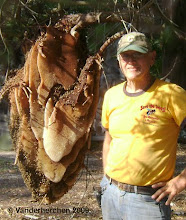 These bees found a hole in the corner of a stucco column just below the soffit. They were also getting in at the corrugation of the soffit. You can see the yellow discoloration at the front of the column. The bees track pollen as they enter and leave.
These bees found a hole in the corner of a stucco column just below the soffit. They were also getting in at the corrugation of the soffit. You can see the yellow discoloration at the front of the column. The bees track pollen as they enter and leave.
Builders leave these columns open at the top with just the aluminum soffit to cover the hole. This gives the bees access to the space inside. It happens to both stucco and block columns.


The resident said the bees were first noticed on Sunday. That means the bees had been there four days. Using a laser heat sensor I determined the bees were in the column. Cutting open the stucco revealed the bees and the comb they had built in only four days. I vacuumed off some of the bees so the comb could be seen. Examination of the comb confirmed the bees had only been there four days. Eggs were seen in the cells but none had hatched to larvae. Bee eggs take four days to hatch.


After the comb was removed a coating of repellent was applied and a screen barrier was placed at the top of the column to keep future bees out. The column was closed up and the hole the bees were using caulked closed.














































